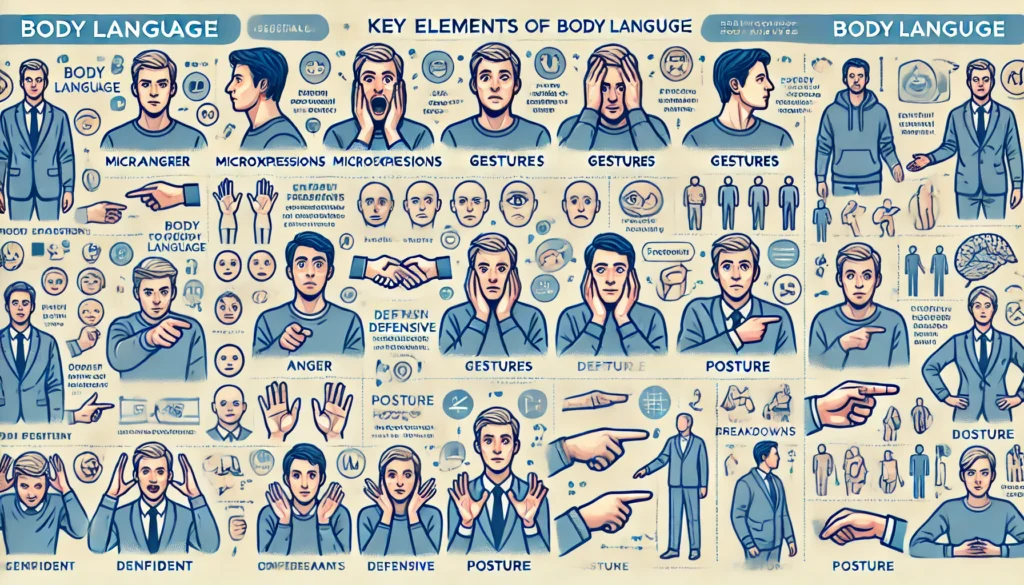A Guide to Nonverbal Communication Speaking Without Words
Mastering Body Language – Did you know that over 90% of human communication is nonverbal? Whether you’re closing a business deal, going on a first date, or navigating a tough conversation, your body language and nonverbal communication can be more powerful than your words. As author and communication expert Peter F. Drucker once said, “The most important thing in communication is hearing what isn’t said.”
In this comprehensive guide, we’ll break down why body language matters, identify common nonverbal cues, and provide practical tips to help you sharpen your nonverbal communication skills in both personal and professional settings.
Understanding the Basics of Body Language
Body language is the silent language of the body—your posture, gestures, facial expressions, and eye contact all send subtle signals that others interpret instantly. It plays a critical role in how we express emotions, build trust, and influence outcomes.
“The body speaks louder than words.” — Dr. Albert Mehrabian, UCLA professor known for his communication studies
Why Is Body Language Important?
- It enhances verbal communication by reinforcing or contradicting your words.
- It influences first impressions in social and professional interactions.
- It helps you build trust, establish rapport, and detect deception.
- It allows you to read others more accurately, enhancing empathy and understanding.
Related Read: The Importance of Nonverbal Communication in Leadership – Forbes
Common Body Language Cues and What They Mean
Understanding common body language signals can significantly improve your interpersonal skills. Here are some of the most frequently used nonverbal cues and their typical interpretations:
✅ Positive Cues
- Open posture: Arms relaxed at sides or slightly open indicate receptiveness and confidence.
- Steady eye contact: Demonstrates confidence, attentiveness, and sincerity.
- Leaning slightly forward: Shows interest and engagement in the conversation.
- Smiling genuinely: Suggests warmth, trustworthiness, and friendliness.
🚫 Negative Cues
- Crossed arms: Often interpreted as defensive, closed off, or resistant.
- Looking away frequently: May suggest discomfort, disinterest, or dishonesty.
- Fidgeting: Signals anxiety, nervousness, or lack of focus.
- Tapping fingers or feet: Can convey impatience or irritation.
Body Language in Cultural Contexts
Remember, body language is culturally nuanced. For instance, maintaining strong eye contact is considered respectful in Western cultures but can be perceived as aggressive in some Asian cultures. Always consider cultural norms when interpreting nonverbal behavior.
How to Improve Your Nonverbal Communication Skills
Improving your body language is a powerful way to become more effective in your communication. Here are some practical, research-backed tips:
1. Practice Self-Awareness
Be conscious of your posture, facial expressions, and gestures. Record yourself during a conversation or presentation and observe your nonverbal habits.
“Awareness of your body language is the first step to mastering it.” – Joe Navarro, former FBI agent and body language expert
Recommended Resource: Joe Navarro’s “What Every BODY is Saying” – A must-read for anyone serious about decoding and controlling body language.
2. Align Verbal and Nonverbal Messages
Ensure that your body language matches your words. For example, if you’re giving praise but your tone is flat and arms are crossed, your message won’t feel sincere.
3. Maintain an Open and Engaged Posture
Stand or sit upright with your shoulders back. Avoid slouching or closed-off positions. This projects confidence and approachability.
4. Use Gestures Naturally
Hand gestures can enhance your speech by emphasizing key points—but don’t overdo it. Keep them smooth and intentional.
5. Improve Your Eye Contact
Aim to maintain eye contact 50-60% of the time during a conversation. This demonstrates confidence and helps build trust.
6. Mirror the Other Person
Subtly mirroring someone’s posture or gestures fosters rapport and shows empathy. Just be natural—don’t mimic.
7. Stay Relaxed
A tense body signals stress or discomfort. Practice deep breathing to stay calm and grounded during important interactions.
Body Language in the Workplace
Nonverbal communication plays a critical role in professional environments—from job interviews to boardroom presentations. Consider these workplace-specific strategies:
- Handshake: A firm but not crushing grip reflects confidence and professionalism.
- Presentation posture: Avoid pacing or turning your back to the audience. Stand tall, make eye contact, and gesture with purpose.
- Listening posture: Nod occasionally, face the speaker directly, and avoid checking your phone or watch.
Internal Link: Check out our guide on dressing to impress for more nonverbal impact in the workplace
Reading Other People’s Body Language

Improving your own body language is only half the equation. Being able to interpret others’ nonverbal cues makes you a more empathetic and effective communicator.
- Notice inconsistencies between words and actions. If someone says they’re “fine” but avoids eye contact and fidgets, they might be hiding discomfort.
- Look for clusters of signals. A single gesture might be misleading, but when several cues point in the same direction, you get a clearer picture.
- Pay attention to context. A folded arm could mean someone is cold, not closed off. Read the room.
Communicate with More than Words
Mastering body language and nonverbal communication can elevate your relationships, career, and confidence. The silent cues we give off are often more influential than the words we speak. By learning to control your own nonverbal signals and decode those of others, you become a more powerful and authentic communicator.
🎯Call to Action: Have you ever had a moment where someone’s body language said more than their words? Share your story in the comments below! And if you found this guide helpful, don’t forget to share it with a friend or colleague who could benefit from better nonverbal communication skills.
Additional Resources
- 📚 The Definitive Book of Body Language – Allan & Barbara Pease
- 🎥 TED Talk: Your Body Language May Shape Who You Are – Amy Cuddy
- 📝 Psychology Today: Nonverbal Communication
By becoming fluent in the language of the body, you unlock a new level of influence and emotional intelligence—essential tools for success in both personal and professional life.
🎯 Bonus Section: Mastering Cold Reading Through Body Language
One advanced application of nonverbal communication is cold reading—a technique often used by mentalists, sales professionals, and negotiators to quickly assess people’s thoughts, intentions, or emotional states without prior knowledge of them. While some associate it with stage magic or “mind reading,” the truth is that cold reading relies heavily on observing body language cues, tone of voice, and microexpressions.
“If you learn how to observe, really observe, people will tell you everything you need to know without ever saying a word.” – Joe Navarro, former FBI body language expert
What Is Cold Reading?
Cold reading is the art of forming accurate impressions about someone using visual cues, subtle behavioral indicators, and environmental context. Unlike hot reading, which relies on prior information, cold reading is about decoding people in real time.
It’s particularly useful for:
- Sales and negotiations
- Leadership and hiring
- Dating and social dynamics
- Security and threat assessment
Cold Reading Body Language Cues to Watch For
Here’s how to apply body language analysis during cold reads:
1. Posture
- Upright and relaxed: Confident and open.
- Hunched or closed off: Anxious, insecure, or guarded.
2. Eye Behavior
- Direct eye contact: Confidence, interest.
- Avoiding eye contact: Nervousness, dishonesty, or discomfort.
- Frequent blinking or looking down: May indicate uncertainty or submission.
3. Hands and Feet
- Hands in pockets or behind back: Hiding something or discomfort.
- Tapping fingers/feet: Impatience or anxiety.
- Open palms facing up: Honesty and openness.
4. Facial Expressions
- Look for microexpressions—quick, involuntary facial expressions that can reveal a person’s true emotions even when they’re trying to hide them.
Example: If someone smiles but the smile doesn’t reach their eyes, it may be insincere.
Tips for Practicing Cold Reading
- Start Small: Practice in casual settings like coffee shops or social events. Try to observe posture, mood, and group dynamics without judgment.
- Use “Barnum Statements”: Broad, generalized statements like “You’re someone who values your independence but also enjoys being appreciated” can often strike a chord and open the door to deeper conversation.
- Calibrate in Real Time: Observe how the person reacts to your questions or statements and adjust your read accordingly.
- Don’t Jump to Conclusions: Cold reading isn’t psychic insight—it’s educated guessing. Always confirm with open-ended questions.
Pro Tip: Pair cold reading with strong active listening skills to build rapport and trust quickly.
Final Thought on Cold Reading
Cold reading is not about manipulation—it’s about connection and awareness. When used ethically, it can help you become more empathetic, perceptive, and persuasive. It takes practice and emotional intelligence, but it can elevate your social skills to another level.
Want to go deeper?
Check out Derren Brown’s book “Tricks of the Mind” for an insightful look into psychological manipulation and cold reading from one of the world’s leading mentalists.
🔗 Related Internal Link:
By combining cold reading with solid body language awareness, you can gain a serious edge in understanding others—and making yourself better understood in the process.




